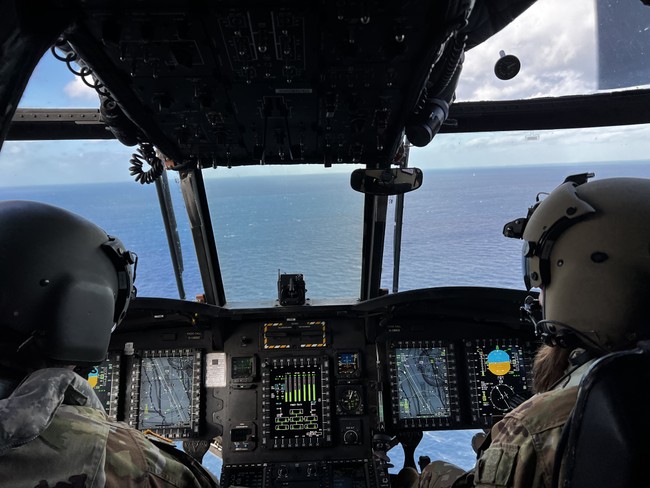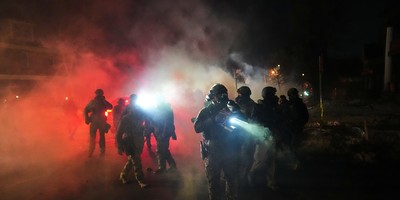FLORIDA KEYS — The CH-47 Chinook belonging to Bravo Company, 1st Battalion, 111th Aviation Regiment took off and started its search pattern early Saturday morning for boats of immigrants traveling from Cuba or Haiti. Recently, the Florida Keys have become a hotspot for illegal migration.
I was on the Chinook for over three hours as the flight crew went over the Atlantic Ocean and the Gulf of Mexico, scanning the waters for any sign of boats attempting to make landfall. Along the way, ships with the Coast Guard were below us, ready to interdict should the crew have a confirmed sighting. Saturday's patrol went all around the roughly 120-mile stretch of the Keys, with the sound of the Chinook making it loud and clear the shores were being watched.
Gov. Ron DeSantis (R) signed an emergency declaration ordering aviation elements of the Florida National Guard to support local law enforcement in the chain of small islands that are popular for their sandy beaches and fishing. The Florida Highway Patrol and extra officers with the Florida Fish and Wildlife Conservation Commission have also been sent to reinforce the overwhelmed Monroe County Sheriff's Office and Border Patrol. White House Press Secretary Karine Jean-Pierre called the deployment one of the latest "political stunts" from DeSantis, saying the firebrand governor has put the lives of illegal immigrants at risk.
The mission for the Guardsmen, while not without its risks, is simple: Reconnaissance, deterrence, and coordinating any rescue operations. In addition to the Chinook, other assets being used include UH-60 Black Hawks and UH-72 Lakotas.
Recommended
 Townhall Media/Julio Rosas
Townhall Media/Julio Rosas
"Basically, we identify, detect, and we report back any migrant landings that we observed, anybody in distress, life-saving issues. We work with our state and local partners basically, call that in to make sure that we get assistance to that boat or to that vessel," battalion commander Lt. Col. Brian Cooper told Townhall.
"I think we're going to be doing a lot of deterrence operations. We cover roughly 612 nautical miles of coastline right now with the assets that we have. We can surge more [assets], which would cover even greater miles out, so the actual square miles we cover alone is definitely going to be added," Cooper added.
Cooper said his unit will be here for as long as they are ordered to and will run patrols day and night. DeSantis' executive order lasts for 60 days but could be extended if boats continue to land in the Sunshine State in large numbers.
Key West Mayor Teri Johnston and Marathon City Manager George Garrett explained to Townhall how the National Guard and state law enforcement being sent to the islands has provided much-needed relief for their small towns. The migrants' landings have created a humanitarian crisis in the area. Those fleeing Cuba and Haiti are often traveling on tiny vessels not meant for rough seas. These boats, which are often overcrowded, can also result in drownings in the Straits of Florida.
A Washington Post article from 1991 reported at the time an estimated 25 to 50 percent of Cubans die while attempting to reach U.S. shores. The Tampa Bay Times reported in December the Monroe County Medical Examiner's Office went from handling three migrant bodies in 2021 to 20 confirmed migrants and one person who was likely part of a large group of people from Haiti in 2022. Those bodies, of course, are the ones who are not lost to the unforgiving seas.
U.S. Customs and Border Protection reported Border Patrol agents have seen a sharp increase in encounters in the Miami Sector, which include the Keys. In fiscal year 2021, the total number of encounters was 1,031. For fiscal year 2022, that number jumped to 4,009, and so far in fiscal year 2023, the number is at 2,048. In the emergency declaration DeSantis signed, it states there have been approximately 8,042 migrants who were interdicted in Florida's territorial water since August 2022.
The reinforcements could not have come at a better time for the beleaguered Border Patrol agents stationed in the Keys. One former agent who was stationed in the area told Townhall about how drastically the operational environment has changed since Joe Biden became president.
"During the tail end of 2016, early 2017, landings had decreased from approximately four a week to a trickle. This continued through 2020. There were still landings, but they were few and far between, and when they did happen, there was a coordinated effort to do it covertly coordinating pick-ups where the Border Patrol was a day late and a dollar short," the agent explained.
The Border Patrol station on Marathon went from 22 sworn agents in 2016 to about 15 over the next few years.
"All the while, two shifts were run with days off, leave, and mandatory training, leaving 106 miles patrolled on land with three or four agents during the day and about the same amount at night. In 2021, blatant landings started to rear their ugly head again," the agent said. "With the large numbers of people crossing in Texas, agents from Marathon were sent to Texas as well, leaving the station with eight or ten agents to continue two shift operations."
The management within Border Patrol's Miami Sector had to stop sending agents from Florida to the U.S.-Mexico border once it became clear the illegal boat landings were not going to stop. What followed is exactly the same as what has happened at hot spots along the southern border.
"What work became in the Florida Keys was landings came in, tied up all holding space, and no agents could leave the station to patrol unless it was to go and pick up another landing," the agent said, adding they have been told there are now only three permanent agents and three supervisors left for the entire Keys. Additional agents and air assets have been assigned to the region on a temporary basis, but like the southern border, it's a stopgap measure.
"Most boats do not have the hold to keep food and water stores sufficient for an unguided trip," the agent said about the dangers of travel. "It is obvious most of the people look terrible after a trip and are suffering from dehydration and exposure to the elements. This doesn't even go into the perils of seafaring with sails and or old diesel engines. Even though they come from island nations, not everyone is an accomplished seafarer."
























Join the conversation as a VIP Member